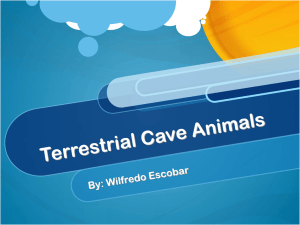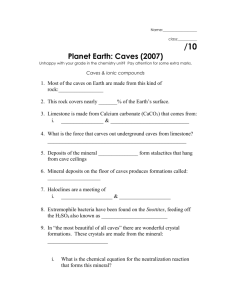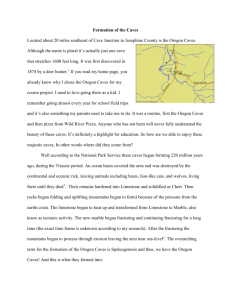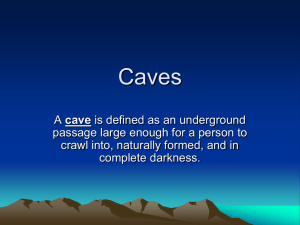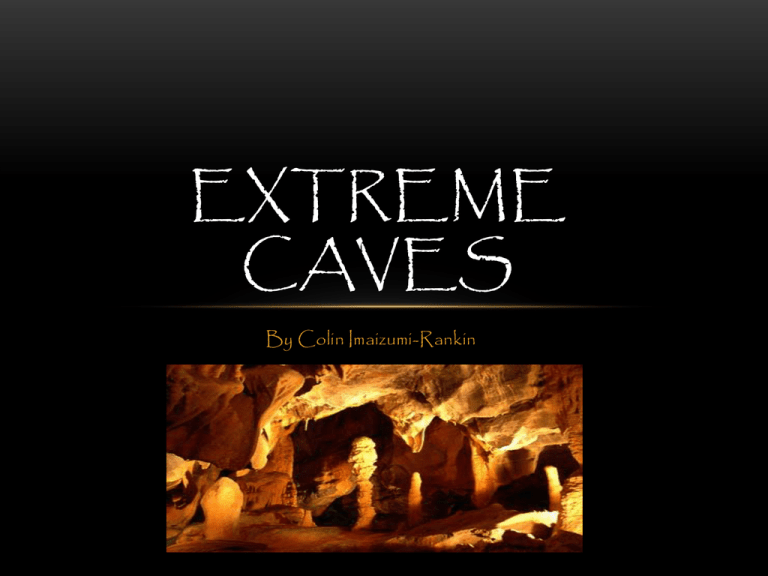
EXTREME
CAVES
By Colin Imaizumi-Rankin
WHERE I WILL RESEARCH
• The area that I am researching is Caves. In this PowerPoint I
hope to show my knowledge of exploration, technology, and
science. I will also have information about some types of caves and
their climates.
INTRODUCTION
• There are four main types of caves: Epigenic caves, Hypogenic
caves, lava tubes, and boulder caves shown in order below.
Epigenic caves are created when surface water goes into cracks or
fissures in the ground and cause the rock to dissolve. A hypogenic
cave is created when rainwater mixes with brine causing it to
dissolve the rock deeper and deeper until the water in the upper
part of the cave drains away. A lava tube is formed when cooling
lava flows away from a volcanic vent. Finally, a boulder cave is
created when rocks collapse on top of a stream causing it to
become blocked off so soil forms on top and plants start to grow.
CLIMATE
• The climate in caves widely vary depending on where the cave is in
the world. In a cave in Wales, the humidity is very high, between
98% to 100% humidity but if there is wind then near the entrance
the humidity can drop to about 75%. Also, in Wales when you go
deep into a cave the temperature will be about 8-9 Celsius.
CAVES IN CANADA
• Canada has many caves, mostly near Toronto, including
interesting names like The Black Hole, Hoodoo Caves,
Chipmunk caves, and the Devil's Bath.
OBSTACLES AND DIFFICULT
CONDITIONS
• Some things that make it hard to survive in an extreme cave are
that there could be toxic gases and/or hostile creatures. Also, the
temperature might be freezing cold or burning hot and there could
be rocks falling and avalanches, or the cave could be underwater.
WHY THIS IS IMPORTANT
• People need to explore caves because then we can find out more
about conditions on our planet and other planets, and be able to
understand interesting phenomenon. Also, you can see how
organisms survive in an extreme environment.
EXPLORATION AND
TECHNOLOGY
PAST EXPLORATIONS
• Cave exploring is called spelunking in Canada and the U.S. and
potholing in the U.K. and Ireland, but most commonly called caving.
In 1910, miners discovered a cave beneath the Naica mine workings,
called the Cave of Swords. The Cave of Swords contains 1meter long selenite crystals. The crystals here are so clear that
they almost look like glass.
TECHNOLOGY
Explore
Survival
• Mapping instrumentsHelps you map out the cave.
• Flashlight and/or helmet
light- This helps you see
• Markers- Marks your path
so you don’t get lost.
• Gas mask- Covers your
mouth so that you don’t
breathe in toxic gases.
• Diving suit- Helps you
explore underwater caves.
• Radio transmitter- Helps
you communicate with
people outside the cave.
• Body suit- This helps you
so that you don’t get
roasted to death or freeze to
death.
CANADIAN INVENTIONS
• Walkie-Talkies
• First patented lightbulb
• Radar
RESPONSIBILITY
• People could explore this region more responsibly if they didn’t
litter and leave anything behind or if they didn’t harm the wildlife. If
they just treaded softly and didn’t touch anything vital to the cave,
the cave could stay there for much longer without being polluted.
BIBLIOGRAPHY
•
http://www.writers-free-reference.com/cheddarcave1.jpg
•
http://www.cave-exploring.com/Cave%20Types.htm
•
http://www.cave-exploring.com/Hypogenic.htm
•
http://www.cave-exploring.com/Boulder.htm
•
http://www.cambriancavingcouncil.org.uk/cavelife/wales/climate.html
•
https://maps.google.ca/maps?hl=en&q=Caves+in+canada+map&bav=on.2,or.r_cp.r_qf.&b
vm=bv.45645796,d.cGE&biw=1600&bih=750&um=1&ie=UTF-8&sa=N&tab=wl
•
http://en.wikipedia.org/wiki/List_of_caves_in_Canada
•
http://en.wikipedia.org/wiki/Caving
•
http://en.wikipedia.org/wiki/Cave_of_the_Crystals
•
http://www.teachersdomain.org/resource/ess05.sci.ess.eiu.lifecondtn/
•
http://wiki.answers.com/Q/What_technology_is_used_to_explore_caves
•
http://www.wondercafe.ca/discussion/social/50-great-canadian-inventions
•
http://www3.sympatico.ca/taniah/Canada/things/
THANK YOU FOR WATCHING!



